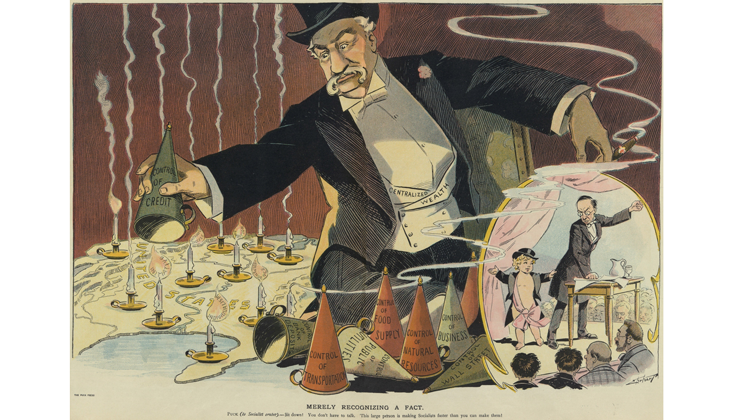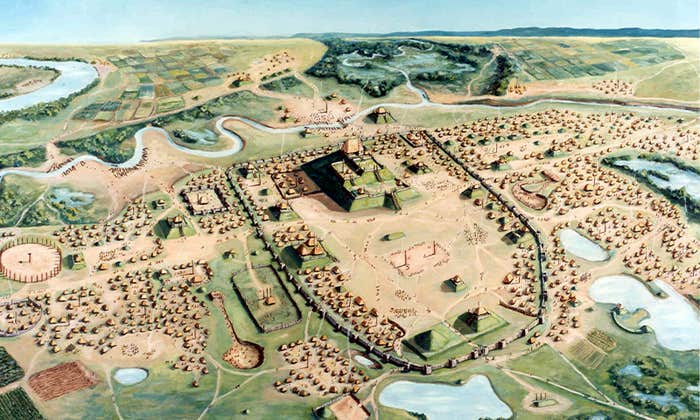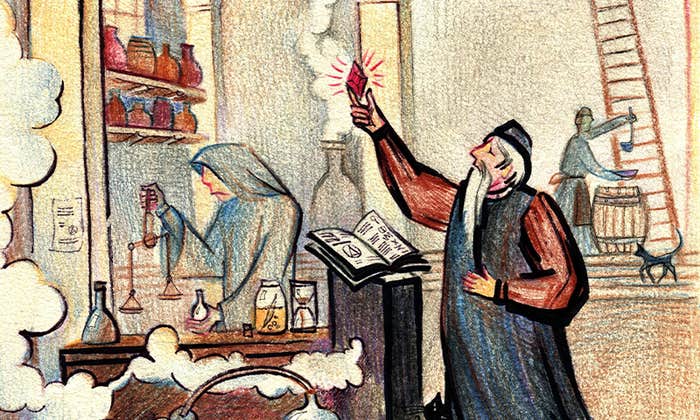The dinosaur is a chimera. Some parts of this complex assemblage are the result of biological evolution. But others are products of human ingenuity, constructed by artists, scientists, and technicians in a laborious process that stretches from the dig site to the naturalist’s study and the museum’s preparation lab. The mounted skeletons that have become such a staple of natural history museums most closely resemble mixed media sculptures, having been cobbled together from a large number of disparate elements that include plaster, steel, and paint, in addition to fossilized bone. When standing before one of these towering creatures, such as the T. rex skeleton named Sue in Chicago’s Field Museum of Natural History, it is surprisingly difficult to distinguish which features are ancient and which ones are modern, where prehistory ends and imagination begins.
If dinosaurs in museums are chimeras, their prehistoric antecedents are unobservable entities. In this respect, dinosaurs resemble subatomic particles like electrons, neutrons, and positrons. Both are inaccessible to direct observation, but for different reasons. Whereas subatomic particles are too small to be seen, dinosaurs are too old. And in both cases, scientists gain access to their objects of study by interpreting the effects they produce: Electrons leave characteristic marks on a photographic emulsion as they pass through a cloud chamber, and dinosaurs supply us with clues to their former existence in the form of fossilized bones.
But dinosaurs are unlike electrons in a number of important ways. For one thing, dinosaurs cannot be experimented upon. Instead, scientists have to interpret the fossil record, which is spotty at best. The first dinosaur discoveries consisted of only a few bones and a handful of teeth. Before long, more complete skeletons began to be found, but the individual pieces were usually scattered about in a jumbled mess of material. Often, they had also been crushed and distorted by the immense pressures at work during and after the process of fossilization. For that reason, paleontologists had to work hard to assemble dinosaurs into something that resembled real, live animals. In doing so, they relied not only on the available evidence, but also on inference, judgment, and their imagination.

Because dinosaurs are in part creatures of the imagination, they reveal a great deal about the time and place in which they were found, studied, and put on display. Often, paleontologists tasked with reconstructing the fragmentary remains of these animals have been guided in their pursuits by analogies to more familiar objects and circumstances. In the mid-19th century, the British anatomist Richard Owen modeled dinosaurs on pachyderms such as the elephant, whereas early American paleontologists looked to the kangaroo as an anatomical guide. It was not until the turn of the 20th century that dinosaurs came to be seen as massive, hulking, and lumbering behemoths of prehistory. More recently, many museums have completely overhauled their aging dinosaur displays yet again, to better reflect contemporary views of these creatures as bird-like, active, and fast-moving, with complex social structures. Dinosaurs simultaneously occupy two widely divergent temporal regimes: They hail from a world in which humans did not exist, yet they are also a product of human history.
Dinosaurs tell us a great deal about ourselves. Their immense size and outlandish appearance all but ensured that dinosaurs would become a mass public spectacle. But the scarcity of their fragmentary remains and the vast temporal chasm that separates their world from ours meant that it was difficult to know much about these creatures with certainty. The mystery of what life might have been like during the depths of time allowed people to project their fears and anxieties, as well as their hopes and fantasies, onto these alien creatures. Taken together, these features helped to make dinosaurs into a favorite target for the philanthropic largesse of wealthy elites, which ensured that there would be plenty of resources devoted to the science of vertebrate paleontology.
During the Long Gilded Age, which stretched from the end of Reconstruction to the start of the Great Depression, financial elites like J.P. Morgan and industrialists like Andrew Carnegie rose to enormous power and influence. They oversaw the transition of the country’s political economy from an unruly and highly competitive form of proprietary capitalism to a more managed economy dominated by large corporate firms. This was precisely when dinosaurs from the American West became an icon of science, and the transition to corporate capitalism affected the practice of vertebrate paleontology in surprisingly concrete and far-reaching ways. Not only did dinosaurs reflect the obsession with all things big and powerful that prevailed at the time, but the science of paleontology itself was profoundly influenced by the creation of large, corporately organized, and bureaucratically managed museums of natural history.
The first dinosaur fossils were uncovered in England during the 1820s and 1830s, and they acquired the name Dinosauria from the British anatomist Sir Richard Owen in 1841. During the decades that followed, many additional fossils came to light, including an especially rich quarry found in a Belgian coal mine that contained dozens upon dozens of Iguanodon specimens. Nonetheless, the earliest dinosaurs did not stand out among all of the other large, impressive, and strange-looking creatures from prehistory that were being unearthed, which included extinct mammals, such as the Megatherium, and marine reptiles, such as ichthyosaurs and plesiosaurs. This suddenly changed during the last third of the 19th century, with a series of new discoveries in the American West that elicited enormous excitement. American dinosaurs were a scientific and popular sensation, especially once their fossil remains were mounted as free-standing skeletons in urban museums at the turn of the 20th century. In part, this was due to the fossils themselves. American dinosaurs struck many observers as bigger and more imposing than their European counterparts. But the United States also proved an especially receptive environment for these creatures, a fertile niche that promoted their development into the towering behemoths that continue to wow museum visitors.
At precisely the same time that dinosaur bones became a public sensation, the U.S. was transforming into an industrial powerhouse of global proportions. Between the end of the Civil War and the beginning of World War I, the country’s economic output grew to exceed that of England, France, and Germany combined. This was due, in no small part, to the development of a robust extractive economy. As a result, the Rocky Mountain region, where many of the continent’s rich mineral resources were concentrated, came to be seen as a land of almost unlimited possibility, and white settlers looking to profit from its abundant resources quickly colonized the region. Simultaneously, more and more people were moving to cities like New York, Philadelphia, Pittsburgh, and Chicago. This included a growing class of wealthy merchants, bankers, and entrepreneurs who bankrolled the process of industrialization. The railroad linked these two worlds together, tying the city and the countryside into an increasingly dense network of supply and demand. Resources flowed in one direction and capital in the other, with a good many people siphoning off a sizeable profit along the way.
Paleontologists worked hard to assemble dinosaurs. They relied on inference, judgment, and imagination.
Because they were so prodigious in size, dinosaurs came to stand in for the power and fecundity of the U.S. In a striking coincidence, three major dinosaur quarries were simultaneously discovered in the American West during a single field season in the summer of 1877. They contained some of the most recognizable fossils, including Stegosaurus, Brontosaurus, and Allosaurus, a close relative of T. rex. Subsequent decades brought more discoveries to light, catapulting the U.S. into position as a world center for vertebrate paleontology. This was still a relatively new science at the time, but the wealth of amazing specimens being unearthed quickly became a scientific and popular sensation. For a people still emerging from the shadow of a bloody civil war, this was a welcome development, and the industrial elite were quick to embrace dinosaurs as their nation’s most iconic extinct creatures. As a result, dinosaurs came to symbolize the country’s economic might and power, offering material proof of its exceptional history and outstanding promise.
With the best specimens hailing from the country’s interior, dinosaurs became associated with its celebrated western frontier. Their discovery was deeply embedded within the extractive economy that dominated the region at this time. In part because the exploitation of mineral resources in precisely this part of the country was so instrumental in propelling the U.S. into the position of an economic superpower, dinosaurs from the American West were elevated into a symbol for the entire political economy. Widely heralded as having been larger, fiercer, and more abundant than prehistoric animals from Europe, they meshed well with a conventional narrative that celebrated American exceptionalism.
Their origin in the deep past ensured that dinosaurs would be associated with evolutionary theory, which was often invoked to explain social, cultural, and economic developments. But dinosaurs did not function as a straightforward image of progress. The mass extinction event that killed them off at the end of the Cretaceous period mirrored the era’s widespread anxieties about degeneration and decline, and dinosaurs were often inserted into a cyclical narrative that characterized evolutionary development as a predictable series of fits and starts. The same evolutionary process was understood, in turn, to result in a familiar pattern of boom and bust that mirrored the emerging conception of what came to be called the business cycle.
The link between dinosaurs and American capitalism was material as well as symbolic. The rapid process of industrialization created riches that had been almost unimaginable just decades before. But the period’s wealth and prosperity was not equally shared among all parts of society. During the late 19th century, a small group of financial and industrial capitalists coalesced into an elite social class that supplanted an older generation of merchant families. Because wealthy industrialists often hailed from fairly humble, artisan backgrounds, they signaled their newfound class status to themselves and each other using traditional markers of high social standing. In addition to wearing expensive clothes and adopting erudite modes of speech, they invested considerable resources in amassing impressive collections of artworks and natural history specimens. Whereas artworks largely functioned as a display of refined aesthetic sensibilities, natural history represented another form of social distinction, one that combined epistemic virtues like objectivity with notions of good stewardship and civic munificence.
Although the economy was booming, American capitalism was in a state of crisis during this period. The industrial juggernaut was responsible for unprecedented levels of economic growth, but it also produced frequent financial panics and economic depressions. Working people were especially hard hit during these downturns, and inequality rose sharply. This led to a widespread backlash against a system of economic production that seemed to yield almost equal measures of growth and precarity, of gratification and misery. A sense of revolutionary uprising was in the air, leading to widespread moral panic among the social and financial elite, who feared that radical immigrants and incendiary labor leaders were spreading an anarchist message that could bring the industrial economy to its knees. Some even worried that a new civil war might be brewing over the issue of wage rather than slave labor. In response, the well-to-do literally armed themselves, forming militias and building ostentatious fortresses that doubled as clubhouses in cities across the U.S.
At the same time, they became avid philanthropists, founding organizations designed to uplift, edify, and educate working people by exposing them to the highest achievements of modern civilization. In the process, they created the nonprofit corporation. These institutions were designed to demonstrate that capitalism could be altruistic as well as competitive—that it worked for the good of all in society, not just the wealthy few.
Dinosaurs came to symbolize the country’s economic might and power, offering material proof of promise.
In addition to establishing universities, libraries, symphonies, and art galleries, wealthy capitalists such as Carnegie founded natural history museums. Natural history doubled as both a popular leisure pursuit and a pious devotional exercise at the time, which made it an especially effective means for showing off one’s generosity among a broad and socially diverse but respectable audience. Of all the branches of natural history, dinosaur paleontology offered a particularly attractive target for philanthropic investment. Dinosaurs lent themselves to the building of spectacular displays that attracted throngs of visitors to the museum, which was crucial to cement the argument that industrial capitalism could produce genuine public goods in addition to profits. Imposing dinosaur displays helped philanthropists such as Carnegie make the claim that because industrial capitalism concentrated wealth in the hands of the few, it unlocked the power for truly awesome achievements.
Philanthropists were also drawn to dinosaurs as a powerful tool to help naturalize the evolution of American capitalism. Before the Civil War, the business landscape of the U.S. was dominated by small, family-owned firms that specialized in a single product or service. But that changed dramatically during the last third of the 19th century, as sole proprietorships were increasingly replaced by large, capital-intensive, and often vertically integrated corporate firms. As these corporate behemoths gobbled up their competitors in a wave of mergers and acquisitions, some grew so large that they threatened to monopolize an entire industrial sector. This restructuring of America’s political economy elicited enormous controversy, especially among rural populations who found themselves on the receiving end of the bureaucratic machine.
Wealthy elites responded by framing the transition to a political economy ruled by vast corporations as an example of evolutionary progress, celebrating the capacity of rational administration and organized planning to replace what they characterized as wasteful and “ruinous” competition between small, independent firms. Dinosaurs offered an especially powerful means to make that claim convincing. Paleontologists consistently portrayed these animals as vicious and solitary predators whose terrible reign had come to a sudden and ignominious end at the close of the Cretaceous period. But their mass extinction opened up the ecological space for a kinder and gentler world to emerge. According to this evolutionary narrative, the cutthroat competition of the deep past gave way to a more enlightened modernity, as intelligent mammals—including early hominids—put the struggle for existence behind them and began to cooperate for the greater good. The exhibition of dinosaurs in philanthropic museums helped to bolster the argument that the evolution of modern capitalism did not depend upon social conflict or lead to class warfare. On the contrary, it could be framed as a means to promote enlightened administration and organized teamwork over ruthless self-interest and incessant competition.
The history of dinosaur paleontology offers an instructive contrast to how the relationship between science and capitalism is often framed. Science has traditionally been portrayed as a higher calling, one that is insulated from the demands of the marketplace. This led early- to mid-20th-century historians and sociologists to stress the autonomy of science, emphasizing the extraordinary measures that researchers take to police the bounds of acceptable conduct, guard against misinformation, and prevent fraud. On this view, membership in the scientific community is governed by a set of expectations like objectivity and value-neutrality, as well as a commitment to share the results of one’s work free of charge.
However, more recent developments have made these ideas seem hopelessly naive. In today’s world of patented gene sequences, technology transfer offices, and Silicon Valley startups, it has become increasingly difficult to sustain the fiction that science is fundamentally divorced from the marketplace. Instead, newer accounts are more likely to stress the extent to which powerful actors and institutions leverage their access to capital to shape the research priorities of the scientific community. Rather than stress the autonomy of science, many historians now tend to examine how the boundary between science and capitalism has become blurred. Nevertheless, our expectations have remained surprisingly stable, and many are troubled to learn that an important medical trial was bankrolled by the pharmaceutical industry, or that a study on climate change was funded by energy companies.
Paleontologists acquired funding, while wealthy capitalists could claim to be engaged in altruism.
Dinosaurs offer a very different perspective. It is precisely because dinosaurs were so deeply entangled with both science and capitalism that vertebrate paleontologists were especially careful to distance themselves from the world of commercial affairs. Dinosaurs rose to international prominence during a period when the economic elite in the U.S. had plenty of money but suffered from a deficit in legitimacy. In contrast, vertebrate paleontologists were engaged in a prestigious but expensive undertaking. Dinosaurs were not just immensely popular, they were also exceedingly difficult to find and collect. Access to a steady source of funds was essential for anyone wishing to work on these remarkable creatures. As a result, paleontologists might be expected to have touted all the ways they could help further the interests of the wealthy donors who underwrote their endeavors. But in fact exactly the opposite happened.
Rather than broadcast their willingness to enter a quid pro quo agreement with philanthropists, Gilded Age paleontologists instead chose to guard the institutional autonomy of their discipline by insisting that funding be offered with no obvious strings attached. Ironically, this only made paleontologists more attractive to philanthropists, who were eager to distance themselves from their commercial and industrial roots. The two communities forged a strategic alliance with mutual benefits. Paleontologists acquired a steady stream of funding, while wealthy capitalists could claim to be engaged in a genuinely altruistic endeavor. And what better way to support this claim than by investing in a lost world that had entirely disappeared before human beings and the industrial economy had even come into existence?
Today, dinosaurs remain bound up with the culture of capitalism, but in ways that are new and often surprising. After several decades in which the scientific and popular enthusiasm for vertebrate paleontology was in decline, we are now witnessing a dinosaur renaissance.
Much of the recent excitement stems from the explosive idea that modern birds are directly descended from dinosaurs. In much the same way that humans are primates, this means that birds are modern-day dinosaurs. It also means that dinosaurs did not go extinct. In a remarkable case of backtracking causation, so-called non-avian dinosaurs have been almost entirely reimagined. Contemporary paleontologists now envision them not as drab, sluggish, and solitary creatures who roamed the deep past but as active and social animals that were often covered with colorful feathers. Moreover, whereas the overwhelming majority of dinosaurs that fueled both the public and scientific imagination during the Long Gilded Age hailed from the American West, the most spectacular fossils today come from northeastern China.
Like Gilded Age industrialists, today’s Chinese industrialists boost their social distinction with dinosaur collections.
During the mid-1990s, a rural farmer named Li Yinfang uncovered the fossil remains of a small dinosaur in the Liaoning Province of Northeastern China. This specimen has many unique features, but paleontologists were especially excited about the wispy, feathery fringe that ran all along the animal’s back, down to the tip of its tail. This was the first time that anyone had found a dinosaur fossil with intact feathers, and it caused a scientific sensation, both inside and outside of China. As a result, present-day paleontologists have come to regard China in much the same way that late 19th-century predecessors thought of the U.S.
Li’s dinosaur was christened Sinosauropteryx prima (meaning “first Chinese lizard wing”), but in the years since, a great many other spectacular fossils have been un-earthed in Liaoning. Some of these are so well preserved that scientists have even used them to infer the color of dinosaurs, completely upending the modern conception of these remarkable creatures. As the paleontologists Mark Norell recently put it, “now, instead of scaly animals portrayed as usually drab creatures, we have solid evidence for a fluffy colored past.”
Fossilized feathers have even led paleontologists to revise their ideas about dinosaur behavior. Because many such as Sinosauropteryx had colorful but relatively simple feathers that did not impart the aerodynamic properties necessary for flight, it is now widely believed that complex or “pinnate” feathers were only secondarily adapted for that purpose. Initially, they most likely evolved for thermoregulation, for camouflage, and as a signaling mechanism to communicate and attract mates. This further cements the once revolutionary idea that far from having been solitary brutes, at least some dinosaurs were intensely social creatures that may have developed complex family structures.
It has become almost a cliché to compare modern-day China to America during the Long Gilded Age. Much as the U.S. did in the late 19th century, China is undergoing a period of rapid industrialization. China’s explosive economic expansion resembles that of the U.S. in that it has been fueled by an abundance of natural resources, including huge tracts of arable land and large stores of mineral wealth. Economic expansion in both countries has come at the price of widespread corruption, escalating labor unrest, and concerns over environmental degradation, as well as a precipitous increase in economic inequality.
Most striking for our purposes is that as well-to-do segments of both societies developed a taste for conspicuous consumption, dinosaur fossils joined artworks as some of the most sought-after means by which new members of the wealthy elite seek to demonstrate their class status and social distinction. Not unlike Andrew Carnegie did during the 1890s, the industrialist Zheng Xiaoting recently drew on the vast fortune he made in gold mining to found the Shandong Tianyu Museum of Nature, which holds the Guinness World Record for the largest collection of dinosaurs.
The comparison between 19th-century America and present-day China can easily be taken too far, and the global economy has changed dramatically in the past hundred years. The Long Gilded Age was a period of increasing consolidation and market integration. Today’s global economy is on a very different trajectory, due in no small part to the emergence of Asia as a dynamic industrial center. Whereas the late 19th and early 20th centuries saw the rise of vertically integrated corporations, the past several decades have seen a new mantra of efficiency taking hold, one that celebrates small, agile, and adaptable startups whose so-called disruptive innovations have eroded the power and profitability of large and heavily bureaucratized industrial firms.
Given the changes in the global economy, is it any surprise that our understanding of dinosaurs has undergone a dramatic transformation? The past several decades have seen business and political leaders embrace political economist’s Joseph Schumpeter’s notion that a process of “creative destruction” underlies economic development, whereas biologists have revolutionized evolutionary theory with the introduction of game-theoretic models of rational decision-making. Indeed, many biologists now believe that even the most exquisitely complex social assemblages have been produced through natural selection acting on a molecular level. Moreover, while evolutionary biologists have reinterpreted altruistic acts of self-sacrifice as selectively advantageous from a perspective, political economists have renewed their commitment to political liberalism, even as the financial panic of 2008 has caused many of them to shy away from the excesses of the perfect market hypothesis.
No wonder, then, that dinosaurs have been transformed in our imaginations from lumbering behemoths of the prehistoric into agile, intelligent, and intensely social creatures covered by colorful feathers, many of which hail from Asia rather than North America.
Lukas Rieppel is the author of Assembling the Dinosaur: Fossil Hunters, Tycoons, and the Making of a Spectacle. He is the David and Michelle Ebersman Assistant Professor of History at Brown University, where he teaches courses on the history of science, the history of capitalism, and connections between the two in Modern America.
Excerpted from Assembling the Dinosaur: Fossil Hunters, Tycoons, and the Making of a Spectacle by Lukas Rieppel, published by Harvard University Press. Copyright © 2019 by Lukas Rieppel. Used by permission. All rights reserved.
Lead image: EQRoy / Shutterstock
This article first appeared online in our “Story” issue in September, 2019.


























